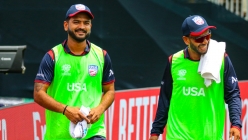The bowling versions of clock-watching employees
2009 Nov 02 by Suresh Menon
It will take a brave selection committee to ask India’s two top bowlers, Harbhajan Singh and Ishant Sharma to keep out of Twenty20. But it must be done. After all, no player is likely to volunteer to give up the most lucrative form of the game.
Like all cricketing stories, the one about the great West Indies batsman Learie Constantine has come down the generations unchanged. That story is of the coach telling the player after he has played a shot, “This is all wrong, look where your feet are” and the immortal response, “Yes, but look where the ball is.” It was said of Rohan Kanhai, of Gordon Greenidge, and doubtless is being said of Chris Gayle today.
This is the Twenty20 approach to batsmanship – look where the ball has gone. Harbhajan Singh’s innings in the first one-dayer against Australia, and Suresh Raina’s in the second are textbook (if one might call it that) examples of this. The front foot does not move towards the line of the ball, but away from it to create the room for a full swing of the bat. If the ball hits the middle it clears the boundary comfortably; a healthy edge carries it into no-man’s land and possibly past the boundary ropes. It is not pretty, but it is effective.
For batting as a visual treat – the classic cover drive, the rousing square cut, the delicate leg glance – we have to go back to old movie footage or television re-runs. Sourav Ganguly took with him the off side elegance, and once Rahul Dravid retires, the on-side grace will have gone too. Rather than the occasional player who plays gracefully, we will have the occasional graceful shot from players who are temperamentally incapable of delicacy or polish consistently.
But we can live with that, consoling ourselves that it is a sign of the times, and that cricket has always reflected society and why should it not therefore lay greater emphasis on effectiveness over style.
Where Twenty20 has contaminated the game to a greater degree is in the bowling, and again Harbhajan Singh is a good example. This off spinner, India’s most successful bowler of his type, has allowed the Twenty20 mentality to color his thinking in the other formats.
The pressure of bowling ‘dot’ balls in Twenty20 has made him send down faster, flatter deliveries with the intention of going past the bat rather than hitting the stumps or inducing a catch. With television sanctifying the dot ball in the bowler’s analysis, it has assumed a disproportionate importance.
When that same tactic is brought into the one-day international, the team suffers because now wicket-taking is important. Nothing slows down the run rate like a wicket or two. The spinner’s role is a more attacking one, especially in the middle overs when batsmen tend to focus on keeping their wickets.
Bowlers, who have a more difficult job to begin with, must learn to pick and choose. Or if they can’t, it must be left to an enlightened system of selection. Part of Ishant Sharma’s recent problem has been a confusion over the approach to the various forms. The answer is clear – he must be kept out of Twenty20 if he is to be a long-term prospect for Tests and one-dayers.
And so too must Harbhajan Singh keep out of Twenty20. It is reducing his effectiveness in the other two forms. He is an attacking off spinner who ought to be taking wickets, whose stock-in-trade is flight and deception. He has been reduced to the bowling version of a clock-watching employee, with his dot ball-watching approach.
It will take a brave selection committee to ask India’s two top bowlers, Harbhajan Singh and Ishant Sharma to keep out of Twenty20. But it must be done. After all, no player is likely to volunteer to give up the most lucrative form of the game.




